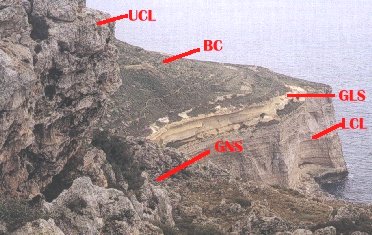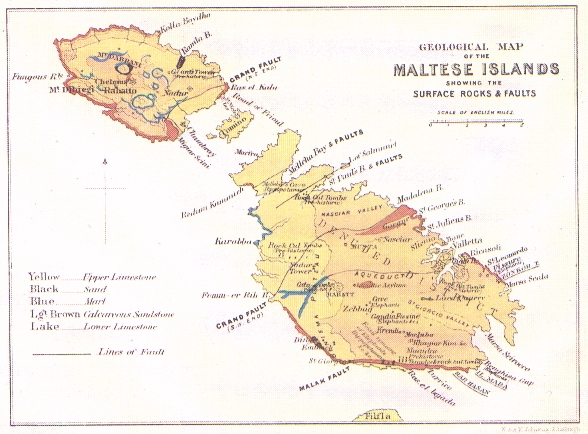 |
 |
By virtue of the mode of formation of Maltese rocks, the stratigraphy follows a definite sequence as indicated in Table 1. This table suggests that the Islands should be covered by an Upper Coralline Limestone cap, however because of the various erosive mechanisms the deeper strata has been exposed.
TABLE 1: MIOCENE STRATIGRAPH
|
|
|
|
|
|
|
|
|
|
|
|
|
|
|
|
|
|
|
|
|
|
|
|
|
|
|
|
|
|
Analysis of typical rock specicems shows an average ofd more than 97% calcium carbonate. The reddish residue after acid treatment is found to consist of clayey matter, iron oxide and mineral fragments, the largest of which are smaller than 0.1 mm diameter. These minerals originated from igneous or metamorphic rocks in the not very distant continental land mass. Phosphoric acid and magnesia were found in small quamntities. The rocks of this horizon may take a good polish and have been sold as Gozo or Malta Marbles. This rock is not a marble in the full petrological sense but merely a polished limestone, since the crystallization of the calcite particles is not sufficiently coarse while the rocks's hardeness is below that of a true marble.
Because of the rock's hardness fossils are difficult to extract in a perfect condition. Large portions of rock are composed of small particles of shells, corals and coralline. The organic remains of this strata suggests that it was laid down at sea depths 30-180 feet. Towards the end of this series the water became deeper, as is indicated by the smaller fragments and the globigerina shells of the upper beds of the strata. The SCUTELLA and NODULE BEDS are often considered as forming the boundery line or transition between the Lower Coralline Limestone and the overlying Globigerina Limestone. associated with the Scutella Bed is BLACK LIMESTONE.
The Lower Coralline Limestone formations have been subdivided into four main beds: [1] Maghlaq Member comprising biomicrites; [2] Attard Member comprising Rhodolite biosparites; [3] Xlendi Member comprising Scutella beds and cross-bedded biosparites; and [4] Il Mara Members comorising Bryozoan and Lepidocyclina beds.
TABLE 2: GLOBINGERINA SUBSTRATA
Following the SCUTELLA or PHOSPHATIC TRANSITION BED
1. Freestone: A pale yellow soft limestone often used for building.
2. A thick seam of Phospahatic nodules (where present).
3. Whitish-yellow fine-grained rock with chert nodules.
4. Soft very fine-grained rock, blue when fresh becoming grey
or white.
5. An irregular band of green coloured nodules.
6. Second seam of brown phosphatic nodules.
7. A thin layer of soft stone with nodules of selenite, manganese,
etc.
8. A seam of phosphatic nodules.
9. Pale grey soft limestone, dark blue when fresh.
Light reddish grey (1) and bluish-green globigerina (2) specimens from New Dock were analysed by C.H. Colson. The insoluble remains contained iron in the ferrous form, abundant alumins and small quantities of lime. Due to the soft nature, and at times even clayey nature, of this matrix, this stratum is very advantageous for fossil collecting.
TABLE 3: GLOBINGERINA & BLUE CLAY CHEMICAL ANALYSIS
....SPECIMENS....................1...........2............3
Calcium Carbonate..............80.24%......78.39%.......2-67%
Calcium Phosphate...............3.57%.......2.70%.......4-30%
Magnesium Carbonate.............1.63%.......0.44%.......traces
Calcium Sulphate................0.06%.......0.33% ......traces
to 2%
Iron Oxide].....................1.13%........-..........4-10%
Alumina...]............................................25-58%
Dilute HCl (1:10) insoluble....12.88%......17.87%.......3-10%
---------------------------------------------------------------------
TOTAL..........................99.51.......99.73
TABLE 4: UPPER CORALLINE SUBSTRATA
Gradual transition from GREENSAND
1. Soft white limestone, very rich in organic remains including
cetacean bones, sharks teeth, and various mollusca species.
2. Reddish coarse-grained limestone very noteworthy for the echinodermata
genus Schizaster which may often be found in fragments strewn in long lines,
resemblings washings of the sea-coast.
3. White rubbly limestone
TABLE 5: MALTESE STRATIGRAPHY
|
[LCL - violet] |
1. LOWER NON-CRYSTALLINE
2. UPPER SEMI-CRYSTALLINE |
Rock compact and crystalline. Colour varies from
white to red, cream or grey.
Transition Bed: Phosphatic Nodules or Scutella Bed (+ Black Limestone) |
|
[GLS - yellow] |
1. Pale yellow soft limestone.
2. Thick seam of Phosphatic nodules. 3. Whitish yellow fine-grained rock with chert. 4. Soft fine-grained rock. Fresh - blue; later grey. 5. Green coloured nodule bed. 6. Brown phosphatic seam. 7. Thin layer of soft stone with nodules of selenite, etc. 8. Seam of Phosphatic nodules. 9. Pale grey soft limestone; dark blue when fresh. |
Transition Bed: Gradual towards Blue Clay. No real demarcation |
|
[BC - blue] |
1. Yellow clays
2. Green clays 3. Grey clays 4. Blue clays |
MINERALS: Gypsum (hardness 2.0); Anhydrite (3.0-3.5);
Iron nodules
NOTE: talus formation Transition Bed: Quite definite |
|
[GNS - green] |
1. Compact red or yellow-red sandstone 2. Soft and loose sandstone with green and black grains. 3. UPPER LIMIT: Bed with grains of calcite |
Transition Bed: Red and white limestone passing
into a white calcareous compact, soft and porous sandstone |
|
[UCL - green] |
1. Soft white limestone.
2. Reddish coarse-grained limestone. 3. Soft white limestone |
NOTE: Arrangement of fossils to resemble shore washings |

Geological Map after A.L.Adams,
1870
|